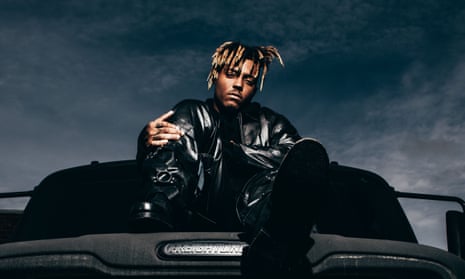Jarad Higgins’ career was a corrective. Growing up, the rapper and singer best known as Juice WRLD listened to hip-hop like everyone else in his hometown of Homewood, Illinois (albeit behind his religious mother’s back). Though the music thrilled him, as a depression-prone teenager, he couldn’t connect to the lyrics about luxury, fast cars and mansions. So when Higgins started recording demos on his iPhone while still in high school, his aim was to fill that void. His songs, he decided, would be impassioned blood-lettings full of frankness and vulnerability that listeners battling similar emotional storms might be able to find comfort in. “Everybody’s got pain,” he said when I interviewed him for the Guardian earlier this year. “Depression, addiction, heartbreak: these are human characteristics.”
Higgins released two albums, two mixtapes and multiple EPs that interrogated those characteristics before his death from a reported seizure in Chicago this weekend. In 2017, the breakout anthems All Girls Are the Same and the Sting-sampling Lucid Dreams propelled him to the pinnacle of emo-rap, a sub-genre he helped tailor into one of the decade’s defining new sounds. Born on SoundCloud, it infused hip-hop with 00s rock heartache: two genres that Higgins, who grew up idolising Kurt Cobain as much as Kanye West, knew intimately. He found the angst he couldn’t see in rap in bands such as Fall Out Boy and Panic! at the Disco: Higgins was perfectly placed to join the likes of Philadelphia rapper Lil Uzi Vert in making emo-rap infamous.
As the popularity of emo-rap rose, so did Higgins, to the brink of genuine superstardom. He found himself entertaining arenas with Nicki Minaj and recording collaborative projects with Future – A-listers whose ranks Higgins seemed primed to join. Death Race for Love, his second album, hit No 1 in the US following its release in March. The album struck a chord with its tormented Auto-Tuned melodies and immersive melancholy moods. The planetary part of his stage name always seemed appropriate: on fan-favourite tracks such as Robbery and Empty, he constructed fraught, fragile other-worlds of knife-edge anxiety and sensitivity.
Death Race’s success sparked something of a referendum on emo-rap’s influence on America’s youth. Some saw Higgins, Lil Uzi Vert and co as offering a positive outlet for young male listeners, often hesitant to share their mental health troubles. To others, tracks like Numb the Pain, full of allusions to self-harm and using narcotics as coping mechanisms, were guilty of deepening existing problems among his target demographic. In 2018, emo-rap was accused of “glorifying” drugs such as fentanyl and Xanax by the US Drug Enforcement Agency following the death of the Long Beach rapper Lil Peep and troubling increases in opioid use by teenagers, allegations that Higgins objected to when it came to his own music. “It’s therapy,” he told me – catharsis for both himself and those who listen. I came away from my interview with Higgins struck by his earnestness and family values. He was surrounded by his long-term girlfriend, a gang of friends and, endearingly, his mum, who helped him factcheck details about his childhood.
In the aftermath of his death, some outlets have been quick to run stories positing that Higgins “predicted” his own death: “What’s the 27 club? / We ain’t making it past 21,” he rapped on 2018 track Legends. But that overlooks not only Higgins’ repeated, poetic confrontation of mortality in his songs (“Lay me down to sleep with my casket closed,” he rapped on Death Race track Rider) but also his evident hunger to build a long-lasting and boundary-busting career. When we met, he lit up when talking about the hardcore album he hoped to make and how he had been studying screaming tutorials on YouTube in preparation. He also talked about finding new ways of reaching people who might benefit from his message: that there’s no shame in vulnerability and nothing to be gained from pushing your feelings down.
Higgins’ death cuts short a career that was just gathering momentum – a depressingly familiar story in recent years for young rap fans. The loss of Juice WRLD follows the losses of fellow rappers Nipsey Hussle, Mac Miller and the aforementioned Lil Peep, as well as the controversial XXXtentacion. For fans of Higgins’ unapologetically emotive sound – heartbroken anthems that trembled with trauma and reached millions – it will hurt to never know the heights he might have scaled.
